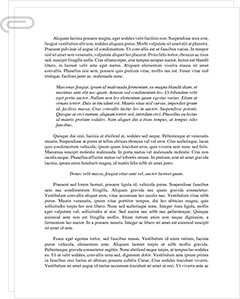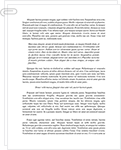 Study Document
Study Document
Leadership Development Plan Essay
Pages:5 (1638 words)
Sources:7
Subject:Business
Topic:Leadership
Document Type:Essay
Document:#72976137
Development Goals
Action Plans
Time Line
Criteria for Success
Communicate more effectively by:
· Engaging in active listening
· Obtaining feedback from workers
· Communicating a vision
· Using social and emotional intelligence skills
· Gain cultural competence
· Ask for input from workers and listen attentively when it is given
· Establishing regular meeting times (formal and informal) so as to engage with workers evenly
· Set time aside to reflect each day on worker feedback
· Develop cultural competency by studying one new culture every week and revisiting old material
· Study human behavior and how people respond w/ words, body language so as to develop SI and EI
· Practice developing and communicating a vision
Open-ended in general, but specific goals can be set for each month:
· Obtaining input should be weekly
· Formal and informal meetings should take place once a week
· Reflection should be 15 mins each day
· 1 hour for cultural studies per week
· 1 hour for human behavior studies
· 30 mins for studying how to communicate a vision
· Worker morale has improved as determined by self-reported surveys
· Workers are more engaged with the leader and vice versa
· The crew is oriented towards the same vision and has bought in to it
· Workers express more positive feedback as a result of leader’s use of EI and SI
Having a leadership development plan is essential for identifying the opportunities available for improving leadership skills, behaviors and styles. It enables one to see which competencies need to be acquired, what key behaviors should be developed, and what styles of leadership should be practiced. The aim of the leadership development plan is to promoted and foster more effective leadership. Shanks and Buchbinder (2012) explain that “leadership development includes both formal and informal efforts” (p. 279). This paper will focus on the competencies, behaviors and styles required to develop effective leadership skills.
Leaders Must be Effective Communicators, Listeners and Engaged in Serving Others
The most important competency for any leader is the need to communicate effectively (Ruben & Gigliotti, 2017). This skill is one that actually includes a number of other competencies: emotional and social intelligence acquisition, cultural competence, the ability to listen and obtain and accept and reflect on feedback; the ability to communicate and express a vision that others can buy into; the ability to serve others and make sure their needs are met (Mikkelson, York & Arritola, 2015). Leadership styles that are needed to gain these skills are transformational and servant leadership styles (Atkin-Plunk & Armstrong, 2013; Warrick, 2011). There are numerous opportunities for me to develop these competencies in my workplace and this plan will identify these opportunities and show how they can be put to use.
Opportunities
Opportunities to…
…of a year the practice should become routine and there should be a marked change in the moral of the people in the workplace. They should show a renewed sense of morale and motivation thanks to being included in the leader’s cogitations.
Communicating the vision is the only key behavior that has to be practiced. This can only be done through repetition and through getting feedback from workers. Surveys should be given to see how well workers are buying into the vision that I communicate, what they think of it, what they think of my approach, and so on. To measure effective communication, feedback is essential.
Service of Others
For me, servant leadership style is the other major style that I want to develop to be a better leader. Serving others is the root of leadership because a leader is one who has to provide others with what they need in order to succeed. A servant leader puts his workers first. This behavior can be practiced by getting to know the workers and their needs and then making myself available to them so that they can get the support they require. This has to be done on an individual basis to truly be effective, which means that each worker needs the opportunity to meet with me on a monthly basis. To measure effectiveness of this competency acquisition, interviews can be conducted to see whether workers are meeting their goals.
Conclusion
To be a more effective…
Sample Source(s) Used
References
Atkin-Plunk, C. A., & Armstrong, G. S. (2013). Transformational leadership skills and correlates of prison warden job stress. Criminal Justice and Behavior, 40(5), 551-568.
Doody, O., & Doody, C. M. (2012). Transformational leadership in nursing practice. British Journal of Nursing, 21(20), 1212-1218.
Leininger, M. (2008). Transcultural nursing: Its importance in nursing practice. Journal of cultural diversity, 15(1), 37-43.
Mikkelson, A. C., York, J. A., & Arritola, J. (2015). Communication competence, leadership behaviors, and employee outcomes in supervisor-employee relationships. Business and Professional Communication Quarterly, 78(3), 336-354.
Ruben, B. D., & Gigliotti, R. A. (2017). Communication: Sine qua non of organizational leadership theory and practice. International Journal of Business Communication, 54(1), 12-30.
Shanks, N. H. & Buchbinder, S. B. (2012). Introduction to health care management. Burlington, MA: Jones & Bartlett Learning.
Warrick, D. D. (2011). The urgent need for skilled transformational leaders: Integrating transformational leadership and organization development. Journal of Leadership, Accountability and Ethics, 8(5), 11-26.
Related Documents
 Study Document
Study Document
Leadership Development Plan
Leadership Development Plan Leadership Development for Mentor To be in position to coach training nurses and uphold care to patient as a first concern. The core objective of training as a nurse is to attain sufficient expertise in patient care and be able to uphold the ethics of nursing while undertaking roles in the professional (Duffy & Hardicre, 2007). The mentor shall endeavor to coach the training nurse towards this goal and
 Study Document
Study Document
Leadership Development Plan Creating, Staffing and Managing
Leadership Development Plan Creating, staffing and managing a virtual team to results presents a very unique set of challenges both form a logistics and leadership standpoint. Creating a state-of-the-art new packaging product that is inexpensive to ship yet durance enough to not get damaged will take cross-functional teams of experts in packaging, physics of containers, logistics, and supply chain systems, in addition to costing and financial analysis. Each of these aspects
 Study Document
Study Document
Analyzing Leadership Development Plan
Leadership Development Plan It is imperative for an effective leader to have a plan in order to succeed. This takes into account a personal plan intended for growth and a professional one intended for improvement. The purpose of this paper is to highlight my personal strengths and weaknesses as a leader, ascertain the areas necessitated for enhancement, and pinpoint the leadership skills and practices that I will employ to become an
 Study Document
Study Document
Analyzing Leadership Development Plan
Leadership Development Plan I am an informed and inquisitive leader, and have sufficient command over functional knowledge and subject matter. Besides this, I can easily grasp ideas and concepts. Paying attention to what others have to say, and supporting them, is a rather easy task for me. I like to take on novel challenges regularly so as to be able to learn new things. I look to multiple sources for inspiration,
 Study Document
Study Document
Personal Leadership Development Plan During
Particular institutions that I will target include: Peachford Hospital, the Atlanta Recovery Center, Mountainside Addiction Treatment Center, and St. Jude's Recovery Center. I expect to do at least three longer phone interviews and one face-to-face interview or shadowing day with a professional in my area. This process will unfold over the next three to six months. I have recently renewed my membership with the American College of Healthcare Executives
 Study Document
Study Document
Creating Leadership Development Plan Leadership
The need in the short-term to create greater confidence in managing the uncertainty of the role is critical. As is the need for creating more opportunities for shared risk with subordinates. The development of this skill however will need to be medium-term as taking extension courses at a local university to make my ability to analyze and solve complex problems and build a more consistent action strategy is critical.




